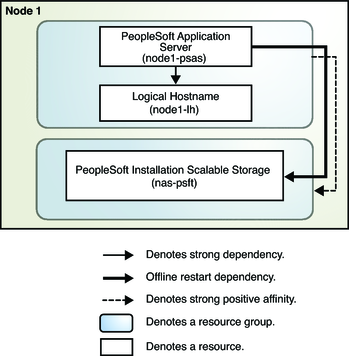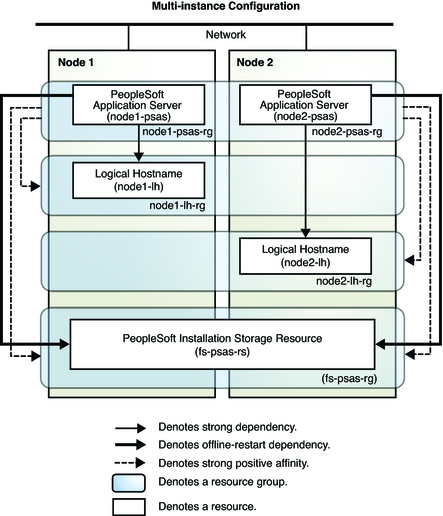| Skip Navigation Links | |
| Exit Print View | |

|
Oracle Solaris Cluster Data Service for Oracle PeopleSoft Enterprise Guide Oracle Solaris Cluster 4.1 |
| Skip Navigation Links | |
| Exit Print View | |

|
Oracle Solaris Cluster Data Service for Oracle PeopleSoft Enterprise Guide Oracle Solaris Cluster 4.1 |
1. Getting Started with Oracle Solaris Cluster HA for PeopleSoft Enterprise
2. Installing and Configuring the HA for PeopleSoft Application Server
Planning the HA for PeopleSoft Application Server Installation and Configuration
Configuration Restrictions for HA for PeopleSoft Application Server
Configuration Requirements for HA for PeopleSoft Application Server
HA for PeopleSoft Application Server Data Service Configurations
Installing and Configuring the PeopleSoft Application Server Domain
How to Enable the PeopleSoft Application Server Domain to Run in a Cluster
How to Install PeopleSoft Application Server Software
Verifying Installation and Configuration of the PeopleSoft Application Server Domain
How to Verify PeopleSoft Application Server Domain Installation and Configuration
Registering and Configuring HA for PeopleSoft Application Server
Tools for Registering and Configuring HA for PeopleSoft Application Server
How to Register and Configure HA for PeopleSoft Application Server for Failover (clsetup)
How to Register and Configure HA for PeopleSoft Application Server for Multi-Instance (clsetup)
How to Register and Configure HA for PeopleSoft Application Server for Failover (CLI)
How to Remove a PeopleSoft Application Server Domain Resource From a Failover Resource Group
Verifying Installation and Configuration of the PeopleSoft Application Server Domain Resource
How to Verify HA for PeopleSoft Application Server Domain Resource Installation and Configuration
Tuning the HA for PeopleSoft Application Server Fault Monitor
Probing Algorithm and Functionality
Operations of the PeopleSoft Application Server Probe
Debugging HA for PeopleSoft Application Server
How to Activate Debugging for HA for PeopleSoft Application Server
3. Installing and Configuring the HA for PeopleSoft Process Scheduler
A. HA for PeopleSoft Application Server Extension Properties
This section contains the information you need to plan your HA for PeopleSoft application server installation and configuration.
The configuration restrictions in the subsections that follow apply only to the HA for PeopleSoft application server.
For restrictions that apply to all data services, see the Oracle Solaris Cluster 4.1 Release Notes.
 | Caution - Your data service configuration might not be supported if you do not observe these restrictions. |
Failover support only - PeopleSoft application server can be configured only as a failover data service and not as a scalable data service.
Multiple application server domains - The Oracle Solaris Cluster resource of resource type ORCL.PeopleSoft_app_server can manage exactly one PeopleSoft application server domain. To manage multiple PeopleSoft application server domains, configure multiple Oracle Solaris Cluster resources of resource type ORCL.PeopleSoft_app_server, each resource managing exactly one PeopleSoft application server domain.
Use the requirements in this section to plan the installation and configuration of the HA for PeopleSoft application server. These requirements apply to HA for PeopleSoft application server only. You must meet these requirements before you proceed with your HA for PeopleSoft application server installation and configuration.
Information about how to install PeopleSoft Enterprise PeopleTools version 8.52 is published in the PeopleSoft PeopleTools 8.52 Install Documentation Library.
For requirements that apply to all data services, see Chapter 1, Planning for Oracle Solaris Cluster Data Services, in Oracle Solaris Cluster Data Services Planning and Administration Guide.
 | Caution - Your data service configuration might not be supported if you do not adhere to these requirements. |
UNIX user and group - The UNIX user and group that are used to install, operate, and manage the PeopleSoft application server domain must exist on all cluster nodes where the corresponding resource for the PeopleSoft application server domain is configured to come online.
File systems - The file systems used to store the required binaries and data for the PeopleSoft application server domain must be configured on highly available local file systems. If you choose to install the binaries on local storage, install and keep them identical on all the cluster nodes. The directory specified for Psft_Cfg_Home must reside on a highly available local file system, which needs to be accessible where the corresponding resource for the PeopleSoft application server domain comes online.
If you are setting up PeopleSoft application server in a multi-instance configuration, the PeopleSoft application server installation should be located on network attached storage (NAS) accessible to all the nodes running the server.
Environment variables - In addition to the required environment variables that are explained in the PeopleSoft Enterprise PeopleTools installation guide, you must set up the following variables before you configure the PeopleSoft application server domain:
SC_LHOSTNAME
LD_PRELOAD_32
LD_PRELOAD_64
Set SC_LHOSTNAME to the logical hostname under which the PeopleSoft application server domain must be reachable from the web tier. For more details, refer to the libschost.so.1(1) man page.
Set these environment variables for the profile of the user that operates the PeopleSoft application server domain. Ensure that the login for the user is noninteractive. If you invoke as user root, you must see these variables displayed in the psadmin command output:
# su - Psft_User -c "/Psft_Home/appserv/psadmin -env"
Database tier dependency - If the database tier is deployed on the same global cluster, the resource for the PeopleSoft application server domain must define a strong resource dependency to the resources for the database instance and database listener. This ensures that the PeopleSoft application server domain will only try to start when the corresponding database is already operational. This configuration is required for a successful startup of the PeopleSoft application server domain. If the Oracle database is not managed through Oracle Solaris Cluster, you can also configure the database tier dependency by using the data service delivered as part of the Oracle External Proxy resource.
Database client network connection - The database client used by the PeopleSoft application server domain configuration must be configured to connect to the network address that is managed by the cluster framework for the corresponding database server.
Use the data service configurations in this section to plan the installation and configuration of the HA for PeopleSoft application server.
When the PeopleSoft software is installed in a traditional file system, a failover deployment requires a configuration where one failover resource group contains the PeopleSoft application server resource, the logical hostname resource, and the failover storage resource. This type of configuration is shown in the following figure.
Figure 2-1 PeopleSoft Application Server Configured for Failover with Traditional File Storage

When the PeopleSoft software is installed on network attached storage (NAS), a failover resource group is configured with the logical hostname resource and PeopleSoft application server resource. A scalable resource group is configured with the NAS storage resource. Such a configuration is shown in the following figure.
Figure 2-2 PeopleSoft Application Server Configured for Failover with NAS

Multi-instance configuration is an application deployment topology where multiple instances of the same application provide an aggregation of services. This topology can be achieved independently of using a data service because you can manually start and stop the instances on the cluster nodes. When HA of such instances is required, you can enable a data service for the instances by creating multiple single-node resource groups or a few multi-master resource groups.
This example illustrates a multi-instance configuration using single-node resource groups. A single-node resource group is created for each of the PeopleSoft application server resources. Each resource group has a strong positive affinity on a storage resource group and a logical host resource group whose primary node is the node containing the PeopleSoft application server resource group.
Figure 2-3 PeopleSoft Application Server Configured as a Multi-Instance Application With Single-Node Resource Groups
